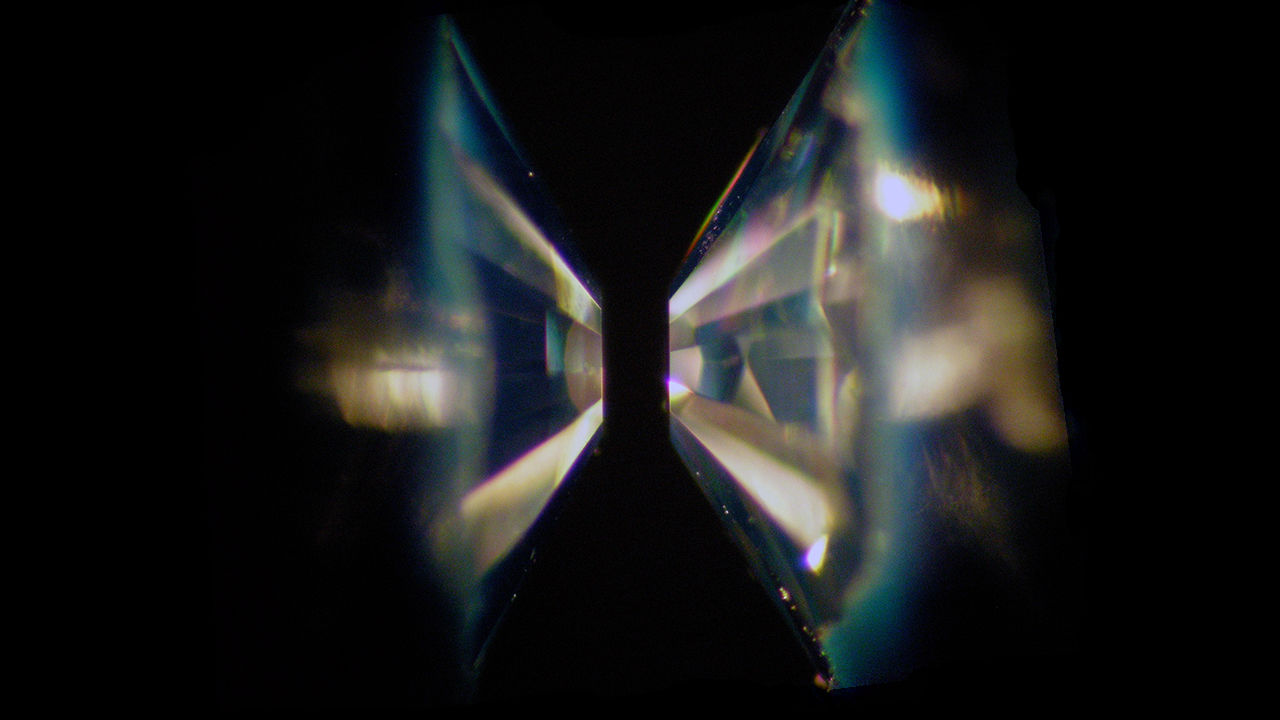Scientists have lost the world's only sample of metallic hydrogen.

Diamond anvils at the time of convergence. They are used to achieve the tremendous pressure needed to produce metallic hydrogen.
Last month, a team of scientists from Harvard University, led by Isaac Silvera and Isaac Silvera, and Ranga Dias announced they were producing metallic hydrogen. To convert the gas into a metallic state, it was necessary to use diamond anvils reinforced with aluminum oxide. Thanks to this, a huge pressure of 495 GPa was achieved.
At the same time, the specialists did not have time to find out what form of metal they got - solid or liquid. They themselves believe that they were able to obtain a liquid form of metallic hydrogen. Unfortunately, now it is not possible to find out this moment, since one of the anvil diamonds collapsed during the course of regular measurements, and the hydrogen sample disappeared.
Perhaps this sample was simply lost, since its dimensions are very small: the diameter is only 10 micrometers. This is about five times smaller than the diameter of a human hair. So it may well be that now metallic hydrogen lies somewhere in the laboratory and waits until it is found.
')
It may also be that after the destruction of the diamond shell, the sample evaporated. The theory predicts that metallic hydrogen should be stable. But how things really are is unclear. If in this part the theory is mistaken, the metallic hydrogen obtained in the laboratory could well be unstable and just evaporate with decreasing pressure. The trouble happened more than a week ago, a few minutes before the diamond anvil was packaged for shipment to the Argonne National Laboratory, which is located in Chicago.
"He has gone. Hydrogen either lies somewhere, or it turned back into gas. We do not know, ”says one of the scientists. He also said that he was upset by what had happened, but now the team is preparing a new anvil, which will be more durable. “We will conduct a new experiment to test whether we can achieve the same pressure as the first time, by obtaining metallic hydrogen,” he says.
Not all specialists believed that a group of scientists from Harvard received metallic hydrogen. To confirm this, it was necessary to conduct a series of tests that, unfortunately, were not carried out, including checking the electrical conductivity of the material. All metals are conductors of electricity, and if it turned out that a sample in a diamond anvil also conducts it, it would be possible to convince almost the entire scientific community in obtaining metallic hydrogen. After the sample was lost, many physicists began to doubt its receipt. A number of scientists were not convinced of the good luck of colleagues from Harvard even before the incident, and after it there were much more skeptics.
“The article is not convincing,” said Paul Loubeyre, a physicist at the French Atomic Energy Commission, who said she was publishing colleagues.

An image of diamond anvils compressing a sample of molecular hydrogen. At high pressure, hydrogen goes into an atomic state, as shown on the right. Source: Dias & Silvera, 2017
According to Silver, they and their colleagues were just about to send a sample for examination using the synchrotron in the Argonne National Laboratory , this is the oldest national research center of the US Department of Energy. Before sending the sample, the scientists decided to measure the pressure in the diamond anvil again using an infrared laser. But if before measurements of this type were made without problems, now everything went wrong. “As soon as we turned on the laser, the diamonds collapsed. One of them turned to dust, ”explains Silvera.
“This is one of the problems that have already happened in other teams, but we thought it would not affect us. We have already taken measurements before, but, as we see, something has changed over time. Probably defects appeared in diamonds, perhaps it was the diffusion of hydrogen. We do not know what happened, ”said Silvera.
At the same time, he is sure that he can get more metallic hydrogen - if not in the next experiment, then very soon. In addition, the scientist is confident that repeating the experiment will convince some skeptics.
“The fact that the sample has disappeared does not say anything about the validity of the sample. Anyone who works with high blood pressure knows that this happens from time to time. It is important that we measured the reflectivity of the sample, it is reliable, ”says the physicist. “Therefore, what happened is not a catastrophe, we are simply disappointed because we can no longer take measurements of the sample.”
"Skeptics will always be there, my advice to them is to try the experiment again - we have shown everything we do with high pressure, having received metallic hydrogen in the laboratory, and therefore other teams will be able to do it," says Silver. “This is a scientific method and it’s better than to question our results.”
At the next stage, scientists are going to use synthetic diamonds of another type, which, presumably, will be more stable. According to them, conclusions were drawn from the incident, so the sample will not be in the laboratory for so long; it will be sent to study almost immediately.
“This can happen if you hold the sample for too long, then its integrity can be compromised in some way, so the next time, after reaching high pressure, we will take measurements as quickly as we can,” say the scientists.
Source: https://habr.com/ru/post/370209/
All Articles